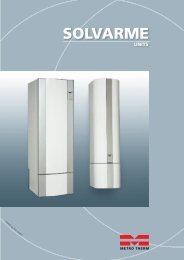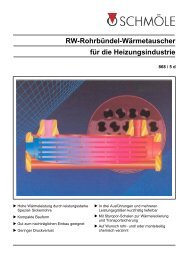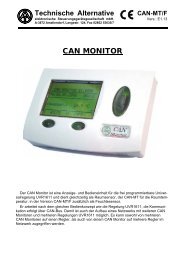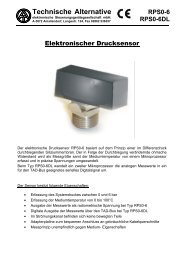Technische Alternative - Varmt vand fra solen
Technische Alternative - Varmt vand fra solen
Technische Alternative - Varmt vand fra solen
You also want an ePaper? Increase the reach of your titles
YUMPU automatically turns print PDFs into web optimized ePapers that Google loves.
DIF Temporary temperature difference between the supply and return line sensor. If<br />
both sensors are immersed in one bath for test reasons (with both thus measuring<br />
the same temperatures), the device should display “DIF 0”. Sensor and measurement<br />
equipment tolerance may, however, lead to a displayed difference under<br />
DIF. If this display is set to zero, the computer saves the difference as a correction<br />
factor and then calculates the heat amount adjusted by the natural measurement<br />
error. This menu item thus provides a way to calibrate to system. The<br />
display may only be set to zero (i.e. changed) if both sensors have the same<br />
measurement conditions (same bath). In addition, the temperature of the test<br />
medium should be around 50-60°C.<br />
HQC CL Clear heat quantity counter. The cumulative amount of heat can be reset with the<br />
� key (=enter).<br />
If the amount of heat is zero, CLEAR is displayed in this menu item.<br />
If the heat counter has been activated, the following are displayed in the basic menu:<br />
the current output in kW<br />
the amount of heat in MWh and kWh<br />
of the volume flow in litres/hour<br />
NOTICE: If an error (short circuit, interruption) occurs at one of the two set sensors (supply<br />
sensor, return sensor) for the heat counter, the current output is set at 0, i.e. no<br />
heat is counted.<br />
Tips on accuracy:<br />
A heat counter can only be as exact as its sensors and equipment. The standard sensors<br />
(KTY) have sufficient accuracy of +/- 1K for the range of 10-90°C used for solar units.<br />
PT1000 types have around +/- 0.5K. The unit’s measurement equipment is accurate down to<br />
+/- 0.5K according to laboratory measurements. PT1000 sensors may be more accurate, but<br />
they have a weaker signal that increases the error. In addition, the proper installation of the<br />
sensors is crucial and can increase error considerably if installed improperly.<br />
If all of the tolerances cumulate in a worst-case scenario, the error would be 40% (KTY) at<br />
a typical temperature difference of 10 K! However, normally the error should be below 10%<br />
as the equipment error affects all of the input channels the same, and the sensors are from<br />
the same production batch. The tolerances thus cancel each other out somewhat. In general,<br />
the greater the differential temperature, the smaller the error. The measurement results<br />
should always been seen just as guide values in all respects. The adjustment due to measurement<br />
differences (see DIF:) leads to a measurement error in standard applications of<br />
around 5%.<br />
32








